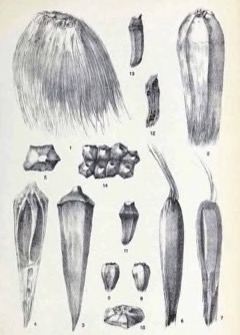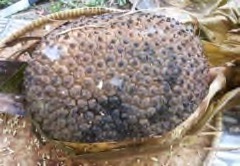 |
|
edibleplants.org |
 |
| wikimedia.org / LISYE IRIANA ZEBUA |
Translate this page:
Summary
Physical Characteristics

 Pandanus julianettii is an evergreen Shrub growing to 4 m (13ft) by 3 m (9ft) at a fast rate.
Pandanus julianettii is an evergreen Shrub growing to 4 m (13ft) by 3 m (9ft) at a fast rate.
See above for USDA hardiness. It is hardy to UK zone 10.
Suitable for: light (sandy) and medium (loamy) soils and prefers well-drained soil. Suitable pH: mildly acid and neutral soils and can grow in very acid and saline soils.
It can grow in semi-shade (light woodland) or no shade. It prefers moist soil. The plant can tolerates strong winds but not maritime exposure.
UK Hardiness Map
US Hardiness Map
Synonyms
Pandanus jiulianettii. There is some confusion with the incorrect spelling: Pandanus jiulianettii.
Plant Habitats
Edible Uses
Edible Parts: Leaves Oil Root Seed
Edible Uses: Oil
Seeds[418 ]. The seeds are oily and contain a fair amount of protein[418 ]. Sometimes the inner leaves and the tips of the aerial roots are eaten cooked[317 ].
References More on Edible Uses
Medicinal Uses
Plants For A Future can not take any responsibility for any adverse effects from the use of plants. Always seek advice from a professional before using a plant medicinally.
None known
References More on Medicinal Uses
The Bookshop: Edible Plant Books
Our Latest books on Perennial Plants For Food Forests and Permaculture Gardens in paperback or digital formats.

Edible Tropical Plants
Food Forest Plants for Hotter Conditions: 250+ Plants For Tropical Food Forests & Permaculture Gardens.
More

Edible Temperate Plants
Plants for Your Food Forest: 500 Plants for Temperate Food Forests & Permaculture Gardens.
More

More Books
PFAF have eight books available in paperback and digital formats. Browse the shop for more information.
Shop Now
Other Uses
References More on Other Uses
Cultivation details
Management: Standard Regional Crop Staple Crop: Oil
A plant of the humid tropics, where it is found at elevations from 1,700 - 2,900 metres[418 ]. Plants grow best in areas where the mean annual temperature is within the range 13 - 24c, but can tolerate 6 - 30c[418 ]. They may tolerate temperatures as low as 0c for short periods and down to 3c for prolonged periods[418 ]. They prefer a mean annual rainfall in the range 3,000 - 4,000mm, tolerating 2,500 - 4,000mm[418 ]. Succeeds in sunny positions and in light shade[418 ]. Prefers a well-drained, humus-rich, light to medium soil[418 ]. Prefers a pH in the range 4.5 - 5.5, but tolerates 3.5 - 5.6[418 ]. Plants can be harvested for their fibre the first time 6 - 8 years from planting, with an economical life of 20-40 years and with a total lifespan of up to 70 years[418 ]. Require 90-120 days from flowering to fruiting and have no obvious seasonality[418 ]. This species has potential for commercial use[317 ]. Branches do not have dormant buds and so will not resprout if cut back into the old wood[423 ]. A dioecious species, both male and female forms need to be grown if fruits and seed are required.
Carbon Farming
-
Management: Standard
Plants grow to their standard height. Harvest fruit, seeds, or other products. Non-Destructive management systems.
-
Regional Crop
These crops have been domesticated and cultivated regionally but have not been adopted elsewhere and are typically not traded globally, Examples in this broad category include perennial cottons and many nuts and staple fruits.
-
Staple Crop: Oil
(0-15 percent protein, 16+ percent oil). Some of these are consumed whole while others are exclusively pressed for oil. Annuals include canola, poppyseed, maize, cottonseed, sunflower, peanut. Perennials include high-oil fruits, seeds, and nuts, such as olive, coconut, avocado, oil palm, shea, pecan, and macadamia. Some perennial oil crops are consumed whole as fruits and nuts, while others are exclusively pressed for oil (and some are used fresh and for oil).
References Carbon Farming Information and Carbon Sequestration Information
Temperature Converter
Type a value in the Celsius field to convert the value to Fahrenheit:
Fahrenheit:
The PFAF Bookshop
Plants For A Future have a number of books available in paperback and digital form. Book titles include Edible Plants, Edible Perennials, Edible Trees,Edible Shrubs, Woodland Gardening, and Temperate Food Forest Plants. Our new book is Food Forest Plants For Hotter Conditions (Tropical and Sub-Tropical).
Shop Now
Plant Propagation
Seed - best pre-soaked for 24 hours prior to sowing[299 ]. Commonly vegetative cuttings of the top section of a branch is used for planting. This is suitable for a tree that has several branches. Sometimes karukas develop young suckers or shoots near the ground. When these are seen, they are broken off and replanted from these vegetative suckers. Trees from cuttings produce after 5-8 years. Seedling trees are slower to produce and have a taller straighter trunk.
Other Names
If available other names are mentioned here
Pandan kelapa hutan fruits, Karunka
Native Range
AUSTRALASIA: New Guinea
Weed Potential
Right plant wrong place. We are currently updating this section.
Please note that a plant may be invasive in one area but may not in your area so it's worth checking.
Conservation Status
IUCN Red List of Threatened Plants Status :

Growth: S = slow M = medium F = fast. Soil: L = light (sandy) M = medium H = heavy (clay). pH: A = acid N = neutral B = basic (alkaline). Shade: F = full shade S = semi-shade N = no shade. Moisture: D = dry M = Moist We = wet Wa = water.
Now available:
Food Forest Plants for Mediterranean Conditions
350+ Perennial Plants For Mediterranean and Drier Food Forests and Permaculture Gardens.
[Paperback and eBook]
This is the third in Plants For A Future's series of plant guides for food forests tailored to
specific climate zones. Following volumes on temperate and tropical ecosystems, this book focuses
on species suited to Mediterranean conditions—regions with hot, dry summers and cool, wet winters,
often facing the added challenge of climate change.
Read More
Expert comment
Author
Martelli
Botanical References
Links / References
For a list of references used on this page please go here
A special thanks to Ken Fern for some of the information used on this page.
Readers comment
| Add a comment |
|
If you have important information about this plant that may help other users please add a comment or link below. Only comments or links that are felt to be directly relevant to a plant will be included. If you think a comment/link or information contained on this page is inaccurate or misleading we would welcome your feedback at [email protected]. If you have questions about a plant please use the Forum on this website as we do not have the resources to answer questions ourselves.
* Please note: the comments by website users are not necessarily those held by PFAF and may give misleading or inaccurate information.
To leave a comment please Register or login here All comments need to be approved so will not appear immediately.
|
Subject : Pandanus julianettii
|
|
|
|